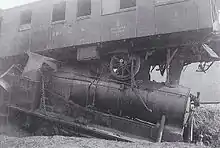Huttwil–Wolhusen railway
The Huttwil–Wolhusen railway is a single-track standard-gauge line in Switzerland and currently operated by BLS AG. It was built by the Huttwil-Wolhusen-Bahn (HWB), based in Willisau, and opened on 9 May 1895. Operations were managed by the Langenthal-Huttwil-Bahn (LHB), which owned and operated the Langenthal–Huttwil railway. On 1 January 1944, the HWB was merged into the Vereinigte Huttwil-Bahnen (United Huttwil Railways, VHB), which was later merged into BLS AG.
| Huttwil–Wolhusen railway | |||||||||||||||||||||||||||||||||||||||||||||||||||||||||||||||||||||||||||||||||||||||||||||||||||||||||||||||||||||||||||||||||||||||||||||||||||||||||||
|---|---|---|---|---|---|---|---|---|---|---|---|---|---|---|---|---|---|---|---|---|---|---|---|---|---|---|---|---|---|---|---|---|---|---|---|---|---|---|---|---|---|---|---|---|---|---|---|---|---|---|---|---|---|---|---|---|---|---|---|---|---|---|---|---|---|---|---|---|---|---|---|---|---|---|---|---|---|---|---|---|---|---|---|---|---|---|---|---|---|---|---|---|---|---|---|---|---|---|---|---|---|---|---|---|---|---|---|---|---|---|---|---|---|---|---|---|---|---|---|---|---|---|---|---|---|---|---|---|---|---|---|---|---|---|---|---|---|---|---|---|---|---|---|---|---|---|---|---|---|---|---|---|---|---|---|
 HWB train hauled by locomotive No. 2 of the LHB in Wolhusen | |||||||||||||||||||||||||||||||||||||||||||||||||||||||||||||||||||||||||||||||||||||||||||||||||||||||||||||||||||||||||||||||||||||||||||||||||||||||||||
| Overview | |||||||||||||||||||||||||||||||||||||||||||||||||||||||||||||||||||||||||||||||||||||||||||||||||||||||||||||||||||||||||||||||||||||||||||||||||||||||||||
| Owner | BLS | ||||||||||||||||||||||||||||||||||||||||||||||||||||||||||||||||||||||||||||||||||||||||||||||||||||||||||||||||||||||||||||||||||||||||||||||||||||||||||
| Line number | 440 | ||||||||||||||||||||||||||||||||||||||||||||||||||||||||||||||||||||||||||||||||||||||||||||||||||||||||||||||||||||||||||||||||||||||||||||||||||||||||||
| Termini | Huttwil Wolhusen | ||||||||||||||||||||||||||||||||||||||||||||||||||||||||||||||||||||||||||||||||||||||||||||||||||||||||||||||||||||||||||||||||||||||||||||||||||||||||||
| Technical | |||||||||||||||||||||||||||||||||||||||||||||||||||||||||||||||||||||||||||||||||||||||||||||||||||||||||||||||||||||||||||||||||||||||||||||||||||||||||||
| Line length | 25.23 km (15.68 mi) | ||||||||||||||||||||||||||||||||||||||||||||||||||||||||||||||||||||||||||||||||||||||||||||||||||||||||||||||||||||||||||||||||||||||||||||||||||||||||||
| Number of tracks | 1 | ||||||||||||||||||||||||||||||||||||||||||||||||||||||||||||||||||||||||||||||||||||||||||||||||||||||||||||||||||||||||||||||||||||||||||||||||||||||||||
| Track gauge | 1,435 mm (4 ft 8 1⁄2 in) | ||||||||||||||||||||||||||||||||||||||||||||||||||||||||||||||||||||||||||||||||||||||||||||||||||||||||||||||||||||||||||||||||||||||||||||||||||||||||||
| Electrification | 15 kV 16.7 Hz AC overhead catenary | ||||||||||||||||||||||||||||||||||||||||||||||||||||||||||||||||||||||||||||||||||||||||||||||||||||||||||||||||||||||||||||||||||||||||||||||||||||||||||
| Maximum incline | 2.5% | ||||||||||||||||||||||||||||||||||||||||||||||||||||||||||||||||||||||||||||||||||||||||||||||||||||||||||||||||||||||||||||||||||||||||||||||||||||||||||
| |||||||||||||||||||||||||||||||||||||||||||||||||||||||||||||||||||||||||||||||||||||||||||||||||||||||||||||||||||||||||||||||||||||||||||||||||||||||||||
History

The initiators of the Huttwil-Wolhusen-Bahn, which were mainly politicians from the Willisau District, saw their project in the 1870s as part of through route that would have connected France and the Gotthard Railway (Gotthardbahn, GB) at Altdorf by the shortest route via Delle, Delémont, Balsthal, Langenthal, Huttwil, Wolhusen, Lucerne and Stans. However, the Jura-Gotthard-Bahn (Jura-Gotthard Railway) project was not completed.
Shortly after the opening of the Langenthal–Huttwil railway by the Langenthal-Huttwil-Bahn, a new initiative committee received a concession for the Huttwil–Wolhusen line on 10 April 1890. The main investor in the railway company, which was founded on 29 March 1893, was the Canton of Lucerne. In addition, the Canton of Bern and various communities participated in the railway. The HWB transferred the operation and maintenance of the Huttwil–Wolhusen line under contract to the LHB on 23/24 June 1894. This allowed the rolling stock of the two railway companies to be used over the whole Langenthal–Wolhusen line. Construction began in the summer of 1893. The opening, which was originally planned for 1 March 1895, was delayed and operations did not begin until 9 May 1895.

The HWB acquired steam locomotive Eb 3/4, listed as number 4, from the Bern-Neuenburg-Bahn (Bern-Neuchâtel Railway) in 1930. However, it proved unsuitable and was scrapped in 1937. Steam locomotive Ec 3/3 5, which was built as a tram engine, began operations in 1936. This high-performance machine, known as the Motorlokomotive was operated by one man and allowed very economical operations. After electrification, it was sold to Sulzer, where it was used as a factory locomotive. Today it is owned by the Historic Heritage Foundation of the Swiss Federal Railways (SBB Historic).[4]
In order to obtain federal aid for rail electrification, the HWB merged with the LHB and the Ramsei-Sumiswald-Huttwil-Bahn (RSHB) on 1 January 1944 to form the United Huttwil Railways (Vereinigten Huttwil-Bahnen, VHB), which immediately formed a joint venture called the EBT Group with the Emmental-Burgdorf-Thun-Bahn (EBT) and the Solothurn-Münster Bahn (SMB). The VHB commenced electrical operations on the Huttwil–Hüswil section at 15 kV AC 16 ⅔ Hertz on 6 August 1945. Electric trains have run on the whole line to Wolhusen since 7 December 1945. The VHB merged with the other railways of the EBT Group in 1997 to form the Regionalverkehr Mittelland (RM), which was merged in turn with the BLS AG in 2006.
Operations

The Wolhusen–Huttwil line has been served hourly by three-part NINA DMUs since the timetable change in 2013. It is part of line S6 of the Lucerne S-Bahn, which runs between Lucerne and Langenthal as part of a portion worked train. The other half of the train runs from Wolhusen to Langnau. On the Wolhusen–Willisau section the timetable is complemented by S7 services, which run every half hour at peak times to Langenthal. It uses the same rolling stock as the S6.[5]
Feight traffic still also plays an important role. The Makies company transports gravel from Zell to the gravel works in Gettnau. It acquired four BDe 4/4 railcars from the Südostbahn (SOB) for this role, with one serving as a source of spare parts.[6] A double-track section between Gettnau and Gettnau freight yard has facilitated operations since 8 December 2006.
References
Footnotes
- "Viel Neues auf Emmentaler Bahn- und Buslinien" (Press release) (in German). BLS AG. 3 December 2009. Archived from the original on 6 October 2011. Retrieved 1 January 2018.
- "Änderungen beim regionalen Bahnverkehr per 12.12.04" (PDF) (in German). Bau, Umwelt- und Wirtschaftdepartement des Kantons Luzern. 31 January 2004. Archived from the original (PDF) on 6 December 2004. Retrieved 1 January 2018.
- Eisenbahnatlas Schweiz [Swiss railway atlas]. Schweers + Wall. 2012. pp. 10, 21. ISBN 978-3-89494-130-7.
- "Ec 3/3 "HWB 5"" (in German). SBB Historic. Archived from the original on 26 October 2013. Retrieved 2 January 2018.
- "440: Langenthal–Wolhusen–Luzern; Langnau–Wolhusen–Luzern" (PDF) (in German). Official Swiss Railway Timetable. Archived (PDF) from the original on 1 January 2019. Retrieved 2 January 2019.
- "Leistungsangebot" (in German). Marti Betriebe Zell. Archived from the original on 9 November 2010. Retrieved 2 January 2018.
Sources
- Schneeberger, Paul (1995). "Wie Willisau und das Luzerner Hinterland durch eine Eisenbahn erschlossen wurden". Schweizer Eisenbahn-Revue (in German). Lucerne: Minirex (5): 195–209. ISSN 1022-7113.
- Wägli, Hans G. (2010). Schienennetz Schweiz, Réseau Ferré suisse (in German). Zürich: AS Verlag. ISBN 978-3-909111-74-9.
- Frey, Thomas; Schiedt, Hans-Ulrich (eds.). "Huttwil-Wolhusen-Bahn". bahndaten.ch. Daten zu den Schweizer Eisenbahnen 1847–1920 (in German). Via Storia, Zentrum für Verkehrsgeschichte. Retrieved 9 January 2018.